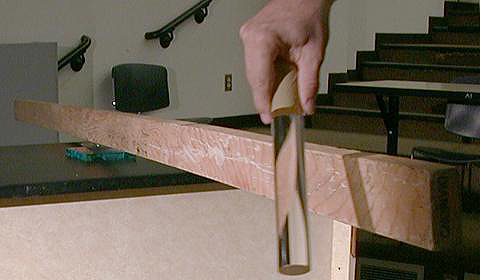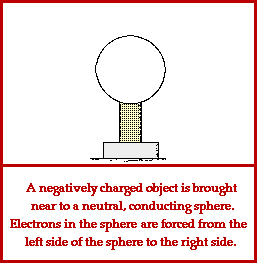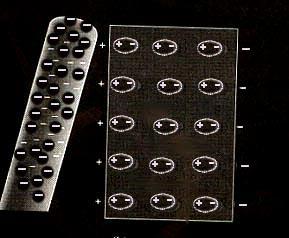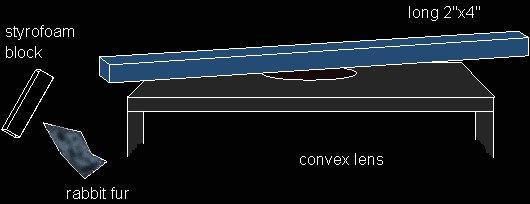

 |
JUST CHARGE IT! |  |
In a darkened room, a great “ psychic” performs a spectacular feat— a plastic drinking straw is balanced on the side of a beer bottle turned horizontal along a tabletop. With great concentration, grunts and gestures, the miracleworker's supernaturally developed willpower causes the straw to move and turn slightly, even though he doesn't touch it. Eventually it slides off the bottle and falls to the table. Spectators are awed and feel privileged to have witnessed such an incredible feat of mind power! In a physics classroom at a large university, 40 bored engineering students who would rather be anywhere else watch as a physics professor balances a 2 x 4 piece of lumber about 6 feet long on a tiny “watch glass,”, a dome-shaped piece of glass about 4 inches in diameter. Bringing out a PVC plastic pipe about 3 feet long, the professor places the pipe near and parallel to one side of the 2 x 4. Incredibly, the large board turns and chases the pipe around in a circle, as the professor walks around the table the board and glass are resting on. In scratchy newsreel footage, a Russian superwoman of the 1970s places a cigar tube on a tabletop. [These tubes, about the size of chemist's test tubes, were made of ultra-thin metal, had a screw top, and were used to protect expensive cigars.] After a moment the miracle-worker brings her fingers close to the tube... incredibly it begins to follow her hand along the table, eventually colliding with her fingers even though she is drawing them rapidly across the table. She pauses a moment, and then shows that the cylinder now runs away from her fingers, rolling mysteriously across the absolutely level tabletop as she keeps her fingers always more than an inch away. In another physics classroom, another bored class watches listlessly as a professor places an empty soft drink can on its side on the tabletop. Now, with his bare hands or with a short piece of PVC pipe, he approaches the can. It starts rolling rapidly away from him, eventually rolling off the tabletop! So few people take high school or college physics classes, and so few of those who do attend have a long enough attention span to remember for more than a few days what they saw there, that almost any demonstration of ordinary physical phenomena can be routined as a demonstration of incredible, supernatural “psychic” powers. Miracle 1 | Miracle 2 | Miracle 3 | Miracle 4 | Miracle 5 | A pocketful of Miracles!
When I was a teenager, all girls wore high-necked wool sweaters over high-necked blouses. At my high school, they quickly discovered that if they would sit in a metal folding chair and squirm around a bit, they could arise and touch someone else and deliver a loud, painful sparking shock.
Here's what's happening in all these demonstrations. Atoms and molecules are, of course, without any net charge; they consist of equal numbers of positively charged protons and negatively charged electrons. But in many molecules, electrons are fairly easy to pull off. If you rub dry human skin, leather, rabbit fur, human hair, nylon or wool with certain other materials, such as wood, amber or other resins such as polyester or vinyl or teflon, many metals, etc., the materials in the first list will lose electrons readily, while the materials in the second list will gain electrons readily. That is, if you rubbed a PVC pipe with rabbit fur, the fur would become positively charged, having lost electrons and thus having an excess of protons, while the PVC pipe would become negatively charged. It was Benjamin Franklin who first showed that the total charge of the two objects remains zero— charge is transferred, not created. The schoolgirls were rubbing wool on a metal alloy chair, charging themselves positively, and the chair negatively.
 |
 |
So suppose you charge your hand positively, or your PVC pipe negatively, it doesn't matter which you use, and you bring the hand or rod near an uncharged aluminum drink can, plastic soda straw or pieces of paper or pieces of metal foil. You will see that the uncharged objects are strongly attracted toward the charged object. How can this be? The answer is that the strength of the electrical force is, as Richard Feynman used to say, “bigger than imagination!” It is incredibly strong, 40 powers of 10 stronger than gravity in equivalent situations. The electrical force that the charged object exerts on the seperate charges in the atoms or molecules of the paper or plastic or aluminum is so strong that the atoms and molecules are distorted, the electrons being pushed one way and the atomic nuclei the opposite way. As the sketches above indicate, if you bring a negatively charged rod or hand near an initially uncharged object, the constituents of the uncharged object are so distorted by the nearby charge that the whole side of the uncharged object nearest the charged object becomes positive, while the opposite side becomes negative... electrons in the uncharged object are pushed as far away from the charged object as possible. Since the force between charges depends very strongly on distance, the near side of the uncharged object is attracted far more than the far side is repelled! Since metals contain electrons that can move freely through the metal, the effect there does not depend on atomic distortion, but rather on these “conduction” electrons moving as far as they can get toward unlike or away from like external charge.

Suppose you're working a miracle and by some ill chance there is a mutant among the audience— someone who, against all the odds, not only took a physics course, but was awake and alert during the lecture on electrostatics, and actually remembers the demonstrations dimly! You can still baffle that troublemaker! All you need to do, after the initial demonstration, is to touch the object that moved, either with your hand or something else. Remember the object you moved has no charge. When you actually touch it, electrons will jump from the object to your hand and leave the object positively charged. Now, when you bring your still positively charged hand near it, it will be repelled instead of attracted. Look at the animated sketch on the left above for another example. In the animation, the initially charged object, a wand, is negative, and the metal sphere is subsequently touched by a third object which is grounded (can store an arbitrarily large amount of charge), so at the end wand and sphere are left with the same charge. This flexibility allows you to switch from attraction to repulsion and then attraction again. Kids of the 1930s and 1940s knew all about this if they played with Mystoplanes! Needless to say, all these demonstrations work best in air of the lowest possible relative humidity— the room should be as cold and dry as possible.
One final note: suppose you want to practice with a plastic drinking straw. Hint: your computer mouse makes a fine “watch glass” to balance the straw on. The straw has not much cross sectional area, but you will find you can also get motion with rising convection currents, as we discussed previously, if you use only one hand. This gives you two physically distinct ways to move the straw. Of course if you're using charge transfer you have to “first dry” your hands by rubbing them against your polyester pants! No problem!
Be aware that magicians have worked out a number of different ways to animate and even levitate objects, ways that will defy any inspection or examination. Would you like to move an ordinary BIC ball point pen with just your “mind”? Well, see it here, or learn more here. Once you've practiced on a BIC, or some other writing pen, you are ready to go on to making a 2 x 2 piece of lumber fall upward from a leaning position, you Psychic Superman, you! Learn more about pseudoscience, here.